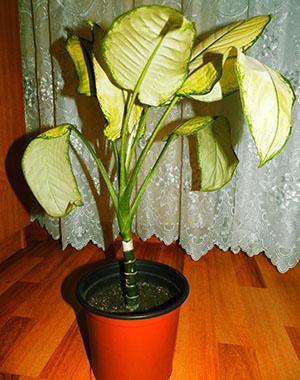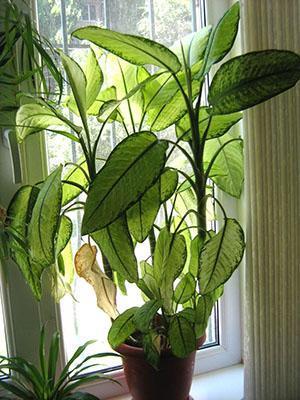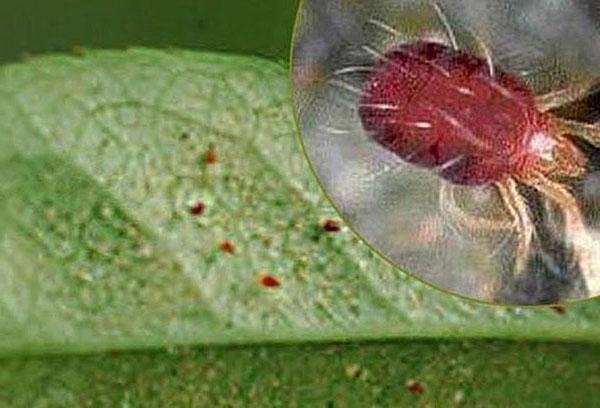Why do your Dieffenbachia leaves turn yellow?
 Dieffenbachia is a beautiful ornamental plant, which is easy to care for. Why dieffenbachia leaves turn yellow, and how to fix the situation, experts advise. A tropical plant requires conditions close to its natural habitat. Before settling dieffenbachia in the house, you need to find out about the conditions of detention. A dying flower will become a dumb reproach for the grower.
Dieffenbachia is a beautiful ornamental plant, which is easy to care for. Why dieffenbachia leaves turn yellow, and how to fix the situation, experts advise. A tropical plant requires conditions close to its natural habitat. Before settling dieffenbachia in the house, you need to find out about the conditions of detention. A dying flower will become a dumb reproach for the grower.
The main factors of correct content
There are three risk factors - improper plant care, pests and diseases. Care is crucial. If the leaves of dieffenbachia turn yellow, this is a signal of trouble. If the problem is eliminated at the first sign, the plant will recover and will delight with beauty for a long time.
In order to grow a straight tree, uniform lighting is required. Therefore, the plant needs to be periodically turned clockwise towards the light source.

- Summer illumination through a tulle curtain is quite comfortable for the plant. In winter dieffenbachia, additional lighting is required, the duration of daylight should be at least 10 hours. With a lack of light, the leaves turn pale, then turn yellow. The sun's rays create necrotic spots.
- Watering with hard water will lead to pallor, and then to yellowness of the leaves. The water should be soft, feeding with Ferrovit with pale leaves, like an ambulance. The leaves will turn brown and dry out if the plant is dry. But why do all the leaves of Dieffenbachia turn yellow at once and suddenly? The plant is flooded, the ground is acidic, the roots rot and do not work. If the rot is not removed and the plant is not transplanted into a new substrate, it will dry out in a few days.
- The soil mixture should be fertile, loose and slightly acidic. In dense soil, with disturbed acidity, salts from the soil are not assimilated. Growth will slow down, the lower leaves will turn yellow. This will be a sign of an imbalanced nutrient balance in the soil. If yellowness starts from the top, vitamin is required feeding balanced composition for decorative deciduous plants.
- The temperature for a dieffenbachia indoor flower should be even, without sudden changes. If there is a short-term decrease to 10-12 degrees, the plant will survive, but the leaves will gradually turn yellow and fall off. Drafts will also lead to yellowing of the plate, its drying. This phenomenon is called necrosis.
The plant intensively cleans the indoor air. Therefore, dust accumulates on the leaves. They must be rinsed in the shower or wiped with a damp cloth.
It should be borne in mind that the plant does not immediately react to an offense, changes occur a week or two after the blow is received. And every such inattention weakens the flower. After that, dieffenbachia is affected by diseases, it becomes a source of food for pests.
 Dieffenbachia pests are:
Dieffenbachia pests are:
- spider mite;
- shield;
- aphid.
All of them feed on plant juices, gradually destroying it. With frequent spraying of the leaves and wiping them with a damp cloth, the tick will not start. He loves dry air. But if the care is negligent, then punctures on the leaves and their yellowing will become noticeable. Reproducing very quickly, the mite will inhabit all plants. Why do dieffenbachia leaves turn yellow from a tick colonization? It multiplies rapidly and sucks the sap from the leaf. If you don't fight, the plant will die.
The scabbard is located on the stems and veins, looks like brown spots, is removed with an alcohol-soap solution. Aphids are washed off, cleaned with soapy water. But if there are a lot of insects, then you have to use a chemical.
Dieffenbachia diseases
 Any change in the appearance of a flower signals a disease. Only a gradual yellowing of the lower leaves and their drying out is a normal physiological process. In other cases, the appearance of any stain or color change is a signal. Bacterial, viral and fungal diseases can affect the plant.
Any change in the appearance of a flower signals a disease. Only a gradual yellowing of the lower leaves and their drying out is a normal physiological process. In other cases, the appearance of any stain or color change is a signal. Bacterial, viral and fungal diseases can affect the plant.
Fungal diseases include:
- anthracosis - black-brown spots on the leaf, yellow border;
- leaf spot - starts with small spots with an orange border;
- root rot - visible as a dark rim on the lower part of the trunk, light gray plaque on top;
- fusarium wilting - affects the root, the vascular system, the plant withers, turns yellow, dies.
All of these diseases are treated with copper preparations. But as a prophylaxis, self-sterilized soil should be used during transplantation. Fusarium is not cured, the plant is destroyed along with the dishes.
Dieffenbachia diseases are called bactericidal, manifesting themselves as weeping spots and ulcers with an unpleasant odor. They also do not respond to treatment. They get rid of the plant, disinfect the dishes.
Viral diseases can be identified by discoloration of the leaf. It can turn bronze and uncharacteristic spots appear. Viruses are transmitted by insects. The plant is not cured.